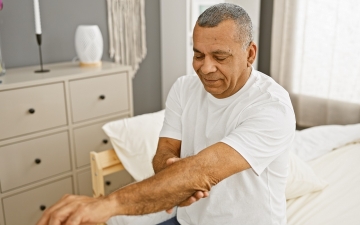
Admission avoidance schemes and early discharge teams have been well-established in the UK for years.[1] These approaches are aimed at getting people admitted to hospital better and back home, as soon as possible – and decreasing the risk of re-admission. The schemes are borne out of necessity, with hospital admissions increasing every year, from 11 million to 16 million in the last twenty years.[2],[3] With figures like these, there may be a need for more hospital wards to be built.
Healthcare closer to home
With admission avoidance schemes and early discharge teams, instead of patients staying in hospital for treatment, care is taken to the patient in the comfort of their own home. Treatments such as intravenous antibiotics can be administered in the community and patient monitoring carried out by in-person home visits by trained healthcare workers.
While these models provide effective care to carefully selected patients, there are restrictions with the number of patients that can be managed at any one time. In addition, there is no method of replicating the quality of patient monitoring found in hospitals.[4]
Building a new model of care
When the COVID pandemic hit the UK, there was a rapid realisation that new systems of providing patient care, and delivering patient monitoring, would be essential. Hospitals otherwise would have been overwhelmed with patients infected with COVID, requiring monitoring and care.
From this, the new model of Virtual Hospital (VH) was developed at West Hertfordshire Teaching Hospitals NHS Trust (WHTH) in March 2020. The first version of the VH provided monitoring, care and support for suspected and confirmed COVID patients who had presented to the Emergency Department (ED). These patients were clinically assessed in the ED and risk assessed using a simple tool. If suitable for care through the VH, patients were supplied with an oxygen saturation probe and discharged home. Daily calls were made to patients by doctors and nurses.
The majority of these patients were managed for the course of their disease at home. With the daily monitoring and review of COVID patients in the VH, those that needed re-admission for supportive hospital treatment could be rapidly detected.
A successful virtual hospital model
The WHTH COVID VH has provided care for over 5,000 patients.[5] Alongside this, up to 3,000 bed days have been saved and 2,400 admissions prevented.[6]
The new VH uses a more comprehensive digital monitoring system using software that can continuously monitor oxygen saturation, pulse, blood pressure and respiratory rate, which are then reviewed by nurses and doctors based in the hospital.
Following a review of these observations, patients receive a call from a nurse and a doctor based in the hospital who clinically assess current symptoms and monitor progress. In addition, a home visit undertaken on the day after discharge is made by a specialist community nurse. Further tests can be organised, and treatment can be extended or changed for patients. Most of these further investigations, such as blood tests and sputum cultures, can be undertaken in the patient’s home with the support of the community nursing team.
In some cases, the patient may need to attend the hospital for further radiological tests such as chest X-ray and computed tomography (CT) of the thorax, if not responding to treatment. As well as treatments such as antibiotics, steroids, and diuretics, additional treatments such as nebulisers and oxygen therapy can be provided at home as part of VH care.
Avoiding hospital admission with the VH
Currently, the WHTH VH has now been extended to provide care for admitted patients with acute respiratory infections (ARI) and frailty. As well as providing an early discharge route for admitted patients, the VH is now an option for patients assessed in the ED who fit the disease-specific criteria to be given treatment in their homes, avoiding a hospital admission. It also accepts selected patients directly from the community, who are developing exacerbations of existing chronic illness after assessment by the appropriate specialist community service.
A positive response
As well as the obvious benefits associated with the reduction in hospital bed days, additional benefits of the VH has been shown in reduced mortality, reduced re-admissions (30 days) and presentations to the ED compared to hospital care.[7]
Initial patient feedback on the VH experience has been overwhelmingly positive. Medical care provided at home with the reassurance of continuous monitoring, daily specialist virtual review and treatment in the comfort of the home has unsurprisingly proven to be very attractive to patients as an alternative to a hospital stay.
With more and more VH models being developed across the country, it is now an essential part of the NHS strategy in providing an alternative to in-hospital care for patients.[8]
Virtual hospitals have been demonstrated to be effective, responsive to patients needs and able to be scaled up to provide care for increasing patient numbers.[9]
Conclusion
As more experience is gained with the VH for common acute medical conditions avoiding hospital admission, it is easy to see how this model of care can be replicated for other conditions such as frailty.
Future VH models using even more digitisation and advances in technology will enable greater inclusion of patients with a continued focus on effective care. Virtual hospitals, in my view, are the new hospitals of the future.
Any advice given and opinions expressed in this article are those of the author and do not reflect the view of Chiesi Limited (Chiesi). All content in this article is for informational and educational purposes only. Although Chiesi strives to always provide accurate information, it is not responsible for and does not verify for accuracy any of the information contained within.
[1] The Health Foundation. Improving hospital discharge in England: the case for continued focus and support. Available at: https://www.health.org.uk/news-and-comment/blogs/improving-hospital-discharge-in-england-the-case-for-continued-focus
[2] NHS Digital. Hospital Admitted Patient Care Activity, 2021-22. Available at: https://digital.nhs.uk/data-and-information/publications/statistical/hospital-admitted-patient-care-activity/2021-22
[3] Statista. Number of admissions to NHS hospitals in England from 2000/01 to 2021/22. Available at: https://www.statista.com/statistics/984239/england-nhs-hospital-admissions/
[4] British Geriatrics Society. Bringing hospital care home: Virtual Wards and Hospital at Home for older people. Available at: https://www.bgs.org.uk/virtualwards
[5] West Hertfordshire Teaching Hospitals NHS Trust. Prime minister recognises game-changing potential of virtual hospitals. Available at: https://www.westhertshospitals.nhs.uk/newsandmedia/mediareleases/2023/january/niall-keenan-virtual-hospital.asp
[6] West Hertfordshire Teaching Hospitals NHS Trust. Our clinical strategy 2021 to 2026. Available at: https://www.westhertshospitals.nhs.uk/about/documents/Clinical-Strategy-2021-2026.pdf
[7] National Institute for Health and Care Excellence (NICE). Alternatives to hospital care: Emergency and acute medical care in over 16s: service delivery and organisation. Available at: https://www.nice.org.uk/guidance/ng94/evidence/12alternatives-to-hospital-care-pdf-172397464599
[8] NHS. 2023/24 priorities and operational planning guidance. Available at: https://www.england.nhs.uk/wp-content/uploads/2022/12/PRN00021-23-24-priorities-and-operational-planning-guidance-v1.1.pdf
[9] NHS Health Education England. Guidance on Pharmacy Services and Medicines Use within Virtual Wards (including Hospital at Home). Available at: https://www.hee.nhs.uk/sites/default/files/documents/Guidance%20on%20Pharmacy
%20Services%20and%20Medicines%20Use%20within%20Virtual%20Wards%20
_including%20Hospital%20at%20Home%20%281%29.pdf



 Dr Ajitha Jayaratnam
Dr Ajitha Jayaratnam 

